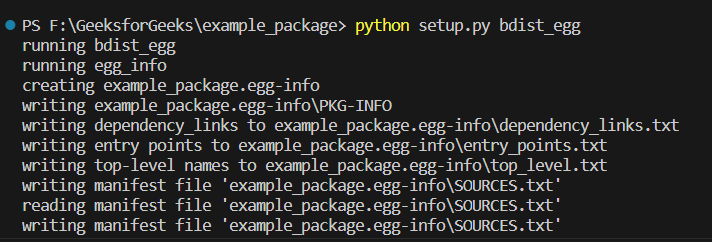What is a Python egg?
Last Updated :
15 Apr, 2024
Python eggs were like special containers for Python software, making it easier to share and install packages. They came about to tackle issues with an older format called “eggs,” which stood for Extensible Gateway Interface. In this article, we will see what is Python egg and how we use it.
What is a Python Egg?
A Python egg serves as a singular, self-contained distribution format for Python packages, encapsulating both metadata—comprising package details and dependencies—and the package code itself. This format aimed to streamline the dissemination and installation of Python packages by establishing a standardized structure, thus facilitating straightforward installation procedures through package management utilities such as setuptools or easy_install.
Key Features of Python Eggs
- Simplified Distribution: Eggs encapsulate Python packages into a single file, making it easier to distribute and share software packages.
- Dependency Management: Eggs can include metadata specifying dependencies on other packages, allowing package managers to automatically install required dependencies during installation.
- Versioning: Eggs can include version information, enabling developers to specify version requirements for dependencies.
- Easy Installation: Eggs can be installed using package management tools like setuptools or easy_install, which handle downloading, unpacking, and installing the package and its dependencies automatically.
- Runtime Environment Isolation: Eggs can contain compiled code and platform-specific resources, enabling developers to distribute packages that are tailored to specific platforms or environments.
How to Create a Python Egg
Below are the step by step approach by which we can create Python egg:
Step 1: File Structure
Let’s assume we have a Python package named example_package with the following directory structure:

File Structure
Step 2: Create example_module.py File
Now, we will write the example_module.py file contains some sample code that will print the Hello, name!.
Python3
# example_module.py
def greet(name):
return f"Hello, {name}!"
Step 3: Write setup.py File
Now, let’s create a setup.py file in the example_package directory to define metadata about our package.
In this setup.py file, we import setup and find_packages from setuptools and then we define metadata such as the package name, version, packages to include (using find_packages()), entry points (which define executable scripts), author information, package description, and URL.
Python3
# setup.py
from setuptools import setup, find_packages
setup(
name='example_package',
version='1.0',
packages=find_packages(),
entry_points={
'console_scripts': [
'example_script = example_package.example_module:greet'
]
},
author='Your Name',
author_email='your@email.com',
description='A simple example package',
url='https://github.com/your_username/example_package',
)
Step 4: Run the Program
To create the Python egg, navigate to the directory containing setup.py and run the following command:
python setup.py bdist_egg
This will generate a Python egg file (with a .egg extension) inside the dist directory within your project directory.
Output:

Generated Python Egg File
We can see a file with .egg extension is created.

The Future of Python Eggs
Python eggs were widely used for packaging and distribution in the Python community for many years. However, they have largely been superseded by newer distribution formats like wheels, which offer improved performance and compatibility. While eggs are still supported by some tools and libraries, they are considered legacy and are no longer recommended for new projects.
Share your thoughts in the comments
Please Login to comment...